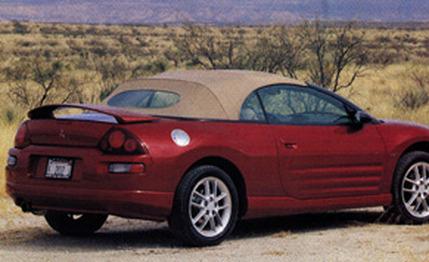
 First Drive Review
First Drive Review
By astronomical dictate, June 20, 2000, is the summer solstice in the Northern Hemisphere. This date often occasions wild sun-worshipping celebrations by primitive and superstitious tribes, like Californians.
Fortunately, by that time Mitsubishi dealers should be fully stocked with the new 2001 Eclipse Spyder, a two-plus-two gamma-ray collector based on the company's freshly redesigned sports coupe.
For Mitsubishi, these are heady times, well worth a pagan sacrifice or two. Annual sales in the U.S. expanded 37 percent, to 261,254, in 1999, making it the fastest-growing Japanese nameplate -- never mind that many of its core products, such as the Eclipse and Galant, are built in Normal, Illinois. And more to come: At the Chicago auto show, the company announced Project America, an effort to base the next generations of the Montero Sport, Galant, and Eclipse on a single platform tooled at the Illinois facility.
For now, the Eclipse coupe, limned in brand-identifying "geomechanical" strakes and simplified arches, is flying off the shelves so fast there is a shortfall of 3.0-liter V-6 engines. The top-of-the-line powerplant represents 50 percent of the Eclipse mix; the hot mill in the previous generation, the turboed 2.0-liter, accounted for only 15 percent of sales. Confirming our suspicion that the new coupe comes off as more mature and masculine (the curvaceous Eclipse of yore was tagged as a chick car), the median age of Eclipse buyers has risen from 28 to 33, and male buyers represent 51 percent of customers, up from 41 percent.
The Eclipse was engineered as a coupe and convertible, so the Spyder's droptop conversion is a rather minor procedure. Unlike the previous generation, whose top was added after the car left the assembly line, the new Spyder is cobbled together alongside the coupe. On the line, reinforcing steel is added around the cabin, and strut-tower braces are added to the front and rear, making the new Spyder 60 percent stiffer in bending rigidity and 10 percent stiffer in torsional rigidity than the previous edition.
One of the things we liked best about the coupe was its overall gravitas, dense materiality, hefty and solid doors, and taut presence of the chassis. Not quite as fiercely stiff, the Spyder can fall prey to petty cowl shake and shudders over rough pavement, of which there is a plenitude in John McCain's glorious homeland.
The weight penalty for the Spyder is between 130 and 190 pounds, depending on the model, not enough to drastically reduce performance, at least not in the GT model, powered by the 200-hp six that puts out 205 pound-feet of torque. The GS, which we didn't drive in Arizona, is powered by a carry-over engine, the 2.4-liter, balance-shaft-equipped in-line four found in base coupes, producing 147 hp and 158 pound-feet of torque. We dare say the GS will feel a little logy in cabrio form.
As a nod to enthusiasts, the coupe's excellent five-speed manual transmission is standard on both GS and GT Spyder models. Both can also be had with the company's four-speed automatic with adaptive logic. Additionally, this transmission can be mated with the Sportronic sequential shift gate.
Inside, the coupe's handsome and serenely technical aesthetic remains unchanged. The cockpit is spacious yet comfortably enclosing. The compartment in which the top is stowed doesn't affect the 20-degree rake of the rear seatback -- a welcome change from the bolt-upright position of the old car. Rear legroom is up an inch over the previous Spyder's, so it is possible to fold a complaisant six-foot-four writer into the back seat with a minimum of unmanly wailing. The Spyder's increase of three inches in length pays off particularly in trunk space, up 2.1 cubic feet. The only real casualty in Operation Spyder is the loss of the ski pass-through, standard on the coupe.
The convertible stack arrives on a pallet from ASC's factory a few miles from the Normal plant. This three-layer, headliner-equipped power top includes a natural rubber layer that, according to Mitsubishi, remains more pliable in extreme weather than the commonly used Butyl. The rear window is glass, wired for defrost. Two small electric motors handle the raising duties. Once the top is installed, the car's windows are raised and the twin-lip rubber gaskets are custom-fitted for better wind and weather deflection.